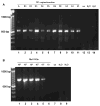Improving molecular tools for global surveillance of measles virus
- PMID: 23806666
- PMCID: PMC5751696
- DOI: 10.1016/j.jcv.2013.05.018
Improving molecular tools for global surveillance of measles virus
Abstract
Background: The genetic characterization of wild-type measles viruses plays an important role in the description of viral transmission pathways and the verification of measles elimination. The 450 nucleotides that encode the carboxyl-terminus of the nucleoprotein (N-450) are routinely sequenced for genotype analysis.
Objectives: The objectives of this study were to develop improved primers and controls for RT-PCR reactions used for genotyping of measles samples and to develop a method to provide a convenient, safe, and inexpensive means to distribute measles RNA for RT-PCR assays and practice panels.
Study design: A newly designed, genetically defined synthetic RNA and RNA isolated from cells infected with currently circulating genotypes were used to compare the sensitivity of primer pairs in RT-PCR and nested PCR. FTA® cards loaded with lysates of measles infected cells were tested for their ability to preserve viral RNA and destroy virus infectivity.
Results: A new primer pair, MeV216/MeV214, was able to amplify N-450 from viruses representing 10 currently circulating genotypes and a genotype A vaccine strain and demonstrated 100-fold increased sensitivity compared to the previously used primer set. A nested PCR assay further increased the sensitivity of detection from patient samples. A synthetic positive control RNA was developed that produced PCR products that are distinguishable by size from PCR products amplified from clinical samples. FTA® cards completely inactivated measles virus and stabilized RNA for at least six months.
Conclusions: These improved molecular tools will advance molecular characterization of circulating measles viruses globally and provide enhanced quality control measures.
Keywords: CDC; Centers for Disease Control and Prevention; Ct; FTA(®) cards; Genotyping; LabNet; MeV; Measles; Molecular diagnostics; RT; WHO; WHO Measles and Rubella Laboratory Network; World Health Organization; cpe; cytopathic effect; measles virus; nt; nucleotides; room temperature; threshold cycle.
Published by Elsevier B.V.
Conflict of interest statement
None declared.
Figures






References
-
- Rota JS, Heath JL, Rota PA, King GE, Celma ML, Carabana J, et al. Molecular epidemiology of measles virus: identification of pathways of transmission and implications for measles elimination. J Infect Dis. 1996;173:32–7. - PubMed
-
- Rota PA, Brown KE, Hubschen JM, Muller CP, Icenogle J, Chen MH, et al. Improving global virologic surveillance for measles and rubella. J Infect Dis. 2011;204(Suppl 1):S506–13. - PubMed
-
- Rota PA, Featherstone DA, Bellini WJ. Molecular epidemiology of measles virus. Curr Top Microbiol Immunol. 2009;330:129–50. - PubMed
-
- Featherstone DA, Rota PA, Icenogle J, Mulders MN, Jee Y, Ahmed H, et al. Expansion of the global measles and rubella laboratory network 2005–09. J Infect Dis. 2011;204(Suppl 1):S491–8. - PubMed
-
- World Health Organization. Nomenclature for describing the genetic characteristics of wild-type measles viruses (update). Part I. Wkly Epidemiol Rec. 2001;76:242–7. - PubMed
Publication types
MeSH terms
Substances
Grants and funding
LinkOut - more resources
Full Text Sources
Other Literature Sources
Medical
Research Materials
Miscellaneous

